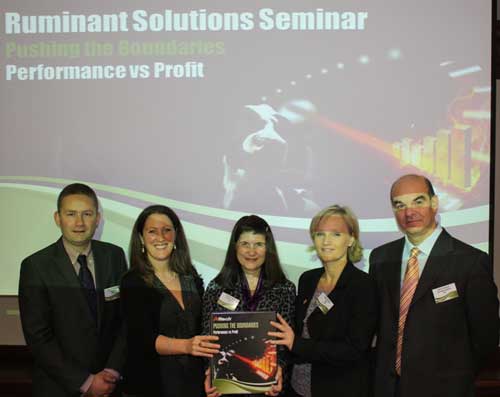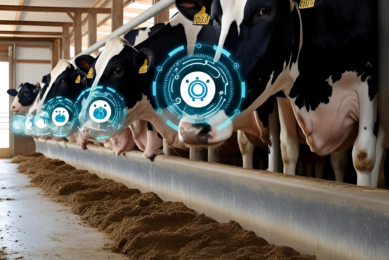Protein costs remain high, ruminant professional say

Four in five top industry ruminant industry professional agree that the current high protein cost won’t change, the said at Alltech’s Ruminant Solutions Seminar.
| Left to Right: Prof. Sarne de Vliegher, University of Ghent; Dr. Judith Capper, Washington State University; Dr. Virginia Isher, Penn State University; Sylvie Andrieu, Alltech and Dr. Paolo Colturato, Team Paragon Consultancy |
The event was attended by 98 top ruminant industry professionals, and took place in Dunboyne, Ireland on the 14th of October 2011.
The seminar, ‘Pushing the Boundaries – Performance vs. Profit’, finished off Alltech’s Solutions Seminar series with a focus on the future of dairy production and how to meet the increasing demand for milk.
Performance and profit
“It’s time to move away from choosing between performance and profit, towards new technologies that will allow us to achieve both.
“This includes pushing physiological limits through feeding the genetic potential of the herd, as well as practical options such as securing the herd’s future with good calf management,” said Sylvie Andrieu, Alltech’s European technical manager for ruminants and chairperson of the Ruminant Solutions Seminar.
“We are at the stage now where we have a dairy cow producing 32,000 litres of milk. It’s not the norm, but some day it could be.”
Key messages:
The key messages from each of the six speakers are as follows:
- “Currently organic systems would require 25% more cows and an additional 30% more land to produce the required amount of milk in the US. This isn’t just about carbon either; it’s about feed, water, land, manure. In other terms, it’s about how we use resources and handle waste.” – Dr. Judith Capper, Washington State University, USA
- “Decreasing the protein content from 18 to 15% does not necessarily lead to lower yield – it’s all about choosing the right feedstuffs, ration calculation and N-efficiency. You can implement any feeding strategy you choose but you have to start with a good foundation – no feedstuff or ingredient can replace a good quality forage and good management.” – Dr. Virginia Isher, Penn State University, USA
- “The danger from a lack of non-protein nitrogen in the rumen during the day can be overcome by the inclusion of Optigen. Nutrition isn’t about a percentage of crude protein, it is about a daily intake of crude protein and the type of protein. Feed the rumen first!” – Dr. Paolo Colturato, Team Paragon Consultancy, Italy
- “Mastitis is the most costly disease in the dairy industry and it cannot be cured by a simple programme or a single tool. You need a multi-factorial approach that recognises individual farm situations and allows for the development of a personalised strategy.” – Dr. Sarne de Vliegher, Ghent University, Belgium
- “Prevent calves from freezing and having a weak immune system. Fever leads to a 25 – 30% increase in energy requirements. Feeding three times a day leads to higher daily gain in comparison to feeding calves twice. Feed your calves three times a day and buy them a jacket!” – Dr. Simon Timmermans, Horizon Beef, Iowa, USA
- “Not all minerals are the same. The type and form of bonding group is more important than size. Inorganic trace minerals create indigestible complexes which leads to low bio-availability. The use of organic trace minerals leads to lower trace element excretion and minimises pollution.” – Dr. Helen Warren, Solutions Deployment Team, Alltech
Survey outcome
98 top industry professionals attended the Alltech Ruminant Solutions Seminar, of those surveyed:
- 64% believe that we can bring dietary crude protein levels to 14% or under.
- 49% think that total replacement is applicable to ruminants.
- 79% agreed that dairy businesses will have to live with high protein costs in the future.
Nutritionists were divided over whether it was possible to increase production levels without damaging animal health, with only 54% agreeing that it was definitely possible.
On the issue of feed price increases, 57% believe costs will rise in the next year, while 28% believe they will not change.
Milk prices also divided attendees with 33% agreeing that prices would rise in the next two years, 30% unsure and 37% disagreeing that they would increase at all.
Most nutritionists believe that their focus should be on producing milk and maintaining health and fertility but 20% think that they should be focussed on the environmental impact of greenhouse gasses.
68% also believe that lowering the environmental impact of dairy production will become an issue of critical importance in the next two years.











